
Scientific Name: The barn owl is scientifically known as Tyto alba.
Global Distribution: Barn owls have a widespread global distribution and can be found on every continent except Antarctica.
Nocturnal Predators: Barn owls are primarily nocturnal, meaning they are most active during the night.
Heart-shaped Facial Disc: Barn owls have a distinctive heart-shaped facial disc, which aids in directing sound to their ears for precise hunting.
Silent Flight: Specialized feathers on their wings enable barn owls to fly silently, allowing them to approach prey without being heard.
Exceptional Hearing: Barn owls have exceptional hearing capabilities, with asymmetrical ear openings that help them locate prey in complete darkness.
Varied Coloration: While generally light in colour, barn owls can exhibit variations from pure white to shades of tan and brown.
Long Legs and Toes: Their long legs and toes are adapted for catching and gripping prey.
Diverse Diet: Barn owls primarily feed on small mammals like mice and voles but can also eat birds, insects, and even small reptiles.
Regurgitated Pellets: After consuming prey, barn owls regurgitate pellets containing indigestible parts such as bones and fur.
High Metabolism: To maintain their energy levels, barn owls need to consume a significant portion of their body weight each night.
Nesting Sites: Barn owls nest in a variety of locations, including tree hollows, cliffs, and man-made structures like barns and church steeples.
Site Fidelity: They often show site fidelity, returning to the same nesting sites year after year.
Monogamous Pairs: Barn owls typically form monogamous pairs, and these bonds can last for life.
Courtship Rituals: Courtship displays involve aerial acrobatics, vocalisations, and the exchange of food between mates.
Mating Season: The barn owl mating season generally occurs in late winter to early spring.
Egg Clutches: A typical clutch may consist of four to seven eggs.
Incubation Period: The incubation period for barn owl eggs is around 30 days.
Hatchling Appearance: Chicks are born covered in soft, white down.
Cooperative Parenting:** Both parents actively participate in incubation, feeding, and raising the chicks.
Fledgling Period: Young barn owls fledge, or leave the nest, at approximately 10 to 12 weeks of age.
Lifespan: In the wild, barn owls typically live for about 2 to 5 years, but some individuals may reach 10 years or more.
Adaptability: Barn owls are highly adaptable to a variety of environments, including farmlands, grasslands, and urban areas.
Human Interaction: They can become accustomed to human activity and may even nest in abandoned buildings.
Population Threats: Habitat loss, pesticides, and road fatalities are among the threats faced by barn owl populations.
Conservation Role: Barn owls play a vital role in natural pest control, helping to keep rodent populations in check.
Biological Indicator: The health of barn owl populations can serve as a biological indicator of ecosystem well-being.
Cultural Symbolism: Barn owls have been symbolically associated with wisdom and intuition in various cultures.
Mythology: In some cultures, barn owls are considered omens or messengers from the spirit world.
Hunting Adaptations: Barn owls use their facial disc to funnel sound to their ears, allowing them to locate prey with great accuracy.
Temperature Regulation: Barn owls have feathered legs, which help regulate body temperature and reduce heat loss.
Wide Wingspan: Their wingspan can range from 75 to 110 cm (30 to 43 inches), allowing for efficient gliding during flight.
Agile Hunters: Barn owls are known for their agility in flight, capable of sudden and precise manoeuvres.
Molt Patterns: Barn owls undergo moulting, shedding old feathers and regrowing new ones.
Barn Owl Species: There are multiple subspecies of barn owls with variations in appearance and distribution.
Echolocation Absence: Unlike some other owls, barn owls do not use echolocation as a primary hunting tool.
Vocal Repertoire: Barn owls produce a range of vocalisations, including screeches, hisses, and chattering sounds.
Distinctive Call: The barn owl’s eerie screech is a distinctive sound often associated with nightfall.
Communication Between Mates: Mated pairs may communicate with soft calls and gentle vocalisations.
Predator Avoidance: Barn owls rely on their camouflaged plumage and nocturnal behaviour to avoid diurnal predators.
Larger Female Size: In many owl species, including barn owls, females are larger than males.
Migratory Patterns: While generally sedentary, some barn owl populations exhibit migratory tendencies in response to seasonal changes.
Human-Friendly Neighbors: Barn owls can coexist with humans, often inhabiting barns and other structures without causing harm.
Educational Ambassadors: Barn owls are often featured in educational programs, raising awareness about their ecological importance.
Agricultural Benefits: The presence of barn owls in agricultural areas contributes to pest control, reducing the need for chemical interventions.
Photogenic Appeal: Their striking appearance and captivating eyes make barn owls a favourite subject for wildlife photographers.
Economic Value: By controlling rodent populations, barn owls provide an economic benefit to farmers.
Influence on Folklore: Barn owls have been featured in various folktales, often symbolising mystery and magic.
Research Subjects: Barn owls are subjects of scientific research, contributing valuable insights into avian behaviour and ecology.
Nature’s Enchanters: With their ethereal presence, haunting calls, and essential ecological role, barn owls stand as nature’s enchanters, weaving their tales across the landscapes they call home.
Last Update:
March 7, 2024
Please share this article if you like it!
Other Articles
Previous


